Vol. 18 #3 June 21, 2016: The Splendor of the Rockies
In This Issue
Flanigan’s Eco-Logic
The Energy Tipping Point: An Editorial
Wooden High Rises
Apple Seeks to Sell Electricity
Flow Batteries Gaining Traction
So What the Heck is a “Yield Co”?
U.S. Rooftop Photovoltaic Potential
Dutch and Danish Energy Islands
In-Line Hydro Generators
Welcoming New Staff

Flanigan’s Eco-Logic: The Splendor of the Rockies
The splendor of late spring in the Colorado Rockies! What an exhilarating time of year to be visiting the snow-capped mountains, touching base with many family and friends in the Roaring Fork Valley! Brother Russell and I have travelled from Vermont and California to Carbondale for brother Bill’s birthday tribute. What a trip. Thanks to Kathy, Bill, Russell, Michael, Chris, Susan, Stuart, Nic, and George. A full and fulfilling time of catching up, celebration, good cheer, mountains, trees, rushing water, and clean air.
Crossing the sky bridge at DIA I got my good glimpse of the mountains, still laden with snow. After tacos and catching up with Michael in Denver, and climbing into the mountains, through the Eisenhower Tunnel… and ultimately the Glenwood Canyon, where we turn south on Highway 82 to Aspen. In the moonlight we gasp at the grandeur of Mount Sopris and find the birthday boy for a late-night, surprise rendezvous.
Waking up, getting out side, breathing in the day. Summer is a’coming in the mountains. It’s going to be a hot day. Streams and rivers are choked with dangerous rapids. We pass endless flows of sparkling water chugging down Capital Creek, Snowmass Creek, the Roaring Fork, Frying Pan, and Crystal rivers. The clouds are bursting with energy, the clearest of blue skies, and the greenest of greens. Trees rustling, residents bustling…
It’s hard not to be struck by the quality of life in the valley. This time of year it is nothing short of idyllic. There’s excitement in the air. We hit Café Bernard in Basalt and then Old Snowmass for a water system meeting at my home there.
Old Snowmass is the same, but my how the trees have grown. The “old” Rocky Mountain Institute headquarters where I worked, once quite barren of vegetation, is now fully settled in. My Shore House, and named after its active-solar designer, builder, and owner Ron Shore, is in great shape, now home to Nic, Mary, baby Emma, and Piper the lab. The new water storage system has changed our water equation; I have six-week storage on site. It’s a great neighborhood.
We head to Redstone to check in on brother Bill who is doing sound for a concert put on by five fathers, Catholic priests. It’s a gorgeous setting along the river, a barbeque, good vibes all around. I put my bare feet in the frigid Crystal River. Then back to Carbondale to help prepare for the birthday gathering of Bill’s friends, the local brethren.
Carbondale is located 170 miles west of Denver, 12 miles from Glenwood Springs, and 30 miles from Aspen. It’s at an altitude of 6,181 feet. A couple of miles off the main drag, the town has a rural, small-town feel, clearly infused with progressive values. People bike and walk about; solar is everywhere. We see the new high school array, and stay cool under a shade structure adorned with panels. People here love their community. Despite recent growth, and transition from farm community to a town with fancy restaurants and now a chic vodka distillery, it’s an unparalleled home base.
Brothers I have, and brothers I love. We’ve been tight for all our years. My older brother is smart, analytical, and hugely kind. He’s a concert soundman and computer programmer. He is hard-wired to take care of people. For us, Bill’s a rock-solid friend for life and that’s not changing. We three have a bond that’s powerful and meaningful… reinforced once again by reunion in the mountains and where Bill calls home.
There’s a profound sense of fulfillment of seeing one’s family member truly loved and admired. We celebrate in a circular reception line involving us all, a deliberate means to meet everyone. Bill is our bond. It’s most apparent that these friends are solid supporters, and they tell us stories of how he has supported them. It’s great to witness and to feel. There are toasts, lasagnas, a smorgasbord of salads, and we sing and eat an oversized carrot cake.
Russell and I relish in knowing that our brother Bill is well and greatly respected. He and Kathy have formed a community, a tight resilient community of locals bonded by their village. And in the splendor of spring in the Rockies, this form of wealth is true and truly wonderful to see.
Quote of the Week:
“If you own a share in a wind turbine it looks better, it sounds better. It sounds like money in the bank.”– Soren Hermansen,Director of the Samso Energy AcademyDenmark’s 100% Renewably-Powered Island
The Energy Tipping Point: An Editorial
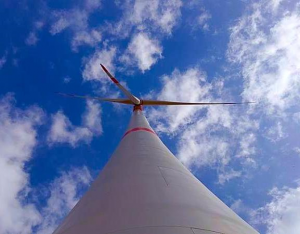 The energy tipping point… it’s in our face. All we hear about is more and more solar, and less coal. More renewables and less fossils. It’s also about new market entrants of note: Apple sells Macbooks, Iphones, and soon electricity? That’s renewable only to be clear. Google is also in the power business. Amazon just cleared a regulatory hurdle to be build an offshore wind farm in North Carolina. There’s even a solar plane – an aerial microgrids of sorts – that just flew across the country: the Solar Impulse.
The energy tipping point… it’s in our face. All we hear about is more and more solar, and less coal. More renewables and less fossils. It’s also about new market entrants of note: Apple sells Macbooks, Iphones, and soon electricity? That’s renewable only to be clear. Google is also in the power business. Amazon just cleared a regulatory hurdle to be build an offshore wind farm in North Carolina. There’s even a solar plane – an aerial microgrids of sorts – that just flew across the country: the Solar Impulse.
Remember Malcom Gladwell’s Tipping Point? He documented when good ideas become ubiquitous. Perhaps like Iphones, his is classic example was wheels on suitcases. For a year or two the wheels seemed a bit fruity, and then wham… Within a few years, they were on every suitcase. It’s unusual to see a suitcase now with no wheels. And soon, it will be unlikely to see a home without solar. It’s just too good an idea to pass.
In the first quarter of 2016, 1,665 megawatts of solar PV were installed in the United States. The solar industry – once as crazy an idea as wheels on a suitcase — added more new capacity during this period than coal, natural gas, and nuclear combined. According to the Solar Energy Industries Association (SEIA), solar capacity accounted for 64% of all new generating capacity brought on-line. This builds on a record 2015 when solar capacity exceeded (tipped over) natural gas additions for the first time.
SEIA projects that in 2016 the U.S. solar industry will install 14.5 gigawatts of capacity, a 94% jump over the 7.5 gigawatts of solar capacity installed in 2015. On the other hand, coal production in the first quarter of 2016 in the U.S. was 173 million short tons, the lowest quarterly level in the United States since a major coal strike in 1981.
Some may say that renewables are only providing a fraction of the power and energy required. Yes, true, like the first suitcases sporting wheels, we have a long way to go. In 2015, renewables produced only 3% of the world’s total energy consumption. While total energy growth slowed to a 1% growth rate, the world’s renewable energy capacity increased by 15% last year. The opportunities in the green power space are enormous as international agreements, national commitments, state and local declarations for a low-carbon economy are now realities. There are now over a million jobs in the wind industry alone.
Look around. We see EVs, solar panels, wind farms… and most importantly a public acceptance of change to a sustainable energy platform. This edition features corporations that are beyond net zero, they are net positive. We document a Danish island that is energy autarkic. In LA where I live, it’s all about trains and live/work spaces, ride and bike shares… all manner of new forms of small-footprint living, coupled with disruptive technologies in play – from Amazon prime, to AirBNB, VRBO, Uber and more. We’ve over the sustainability tipping point. Everyone wants in. We all have, as my colleague Michael notes with great animation, an “e-spot,” something that excites each of us and connects us to the green movement. Ride the wave!
Wooden High Rises

Source: reThink Wood
Worldwide, commercial buildings made of wood are gaining acceptance as architects, developers, and municipal officials seek ways to reduce the carbon footprint of new construction. Unlike concrete, which adds significantly to carbon emissions, wood from sustainable forests absorbs carbon dioxide from the atmosphere and sequesters it for the entirety of a building’s life.
Experts note that the rise of Cross-Laminated Timber (CLT) is the “holy grail” in terms of being able to replace concrete for high rise construction since it’s lighter, stronger and better for the environment. Done right, the wooden buildings are cheaper to build and safer in disasters than steel and concrete ones.
According to the United Nations, approximately 1 ton of carbon dioxide is emitted per ton of cement produced. Because concrete is the second-most consumed substanceon the planet, after water, finding alternatives to its use is a big deal. Cement production accounts for approximately 8% of human-produced carbon dioxide emissions.

CLT Configuration
Given the promise and value of wooden buildings, in 2014 the U.S. Department of Agriculture in partnership with Softwood Lumber Board and Binational Softwood Lumber Council launched the Tall Wood Building Prize Competition. Its goal is “to identify and support proponents who can utilize new scientific information, develop technical expertise and incremental funding available through the Competition to safely design, specify and construct a tall mass timber projects of approximately 80 feet in height or taller in the U.S. that can effectively showcase the application, practicality and sustainability of innovative wood-based structural building solutions.” In 2015, U.S. Secretary of Agriculture Tom Vilsack announced the winners who were granted $3 million in funding to support the development of tall wood demonstration projects in New York and Portland, Oregon.
Vienna will soon be home to the world’s tallest wooden building. The $65 million “HoHo project” will stand 276-feet tall and house a hotel, restaurant, and wellness center plus apartments and offices. The project developer chose wood because of its environmental benefits; fully 76% of the building will be made from wood. The architects say the HoHo tower will save 2,800 metric tons of carbon dioxide emissions compared with a similar concrete structure. That’s the equivalent of driving a conventional car 25 miles every day for 1,300 years.
The idea of such a large wooden building has not met with universal applause. In particular, the Vienna fire service reportedly was not consulted before plans for the building were announced.
Apple Seeks to Sell Electricity
 Worldwide, Apple gets 93% of the electrical energy it needs from solar and other renewable sources. In some states it over-generates. Apple has hundreds of megawatts of solar projects, the power from which runs its stores, offices, and datacenters worldwide. Recently, Apple created a subsidiary – Apple Energy LLC — to sell excess electricity generated by its solar projects. The Cupertino, California-based company has filed a request with the FERC to sell electricity on the wholesale market.
Worldwide, Apple gets 93% of the electrical energy it needs from solar and other renewable sources. In some states it over-generates. Apple has hundreds of megawatts of solar projects, the power from which runs its stores, offices, and datacenters worldwide. Recently, Apple created a subsidiary – Apple Energy LLC — to sell excess electricity generated by its solar projects. The Cupertino, California-based company has filed a request with the FERC to sell electricity on the wholesale market.
Despite excess capacity, and according to its 2016 Environmental Responsibility Report, Apple seeks to add capacity and to generate 521 megawatts of energy through solar production. The company has also invested in other forms of clean energy, including hydroelectric, biogas, and geothermal power.
Some suggest the possible link between Apple’s move into the wholesale power market and its not-so-secret plan to build an electric car. Apple is also known to have an interest in electric car charging technology. Some think that perhaps it plans to create a network of electric car recharging stations powered with renewables to compete with the Tesla Supercharger network.
Apple is not alone among technology giants in the power business. Google is already there. In late 2010 Google created a subsidiary called Google Energy. Shortly thereafter, Google filed a formal request to the FERC to buy and sell wholesale energy. Google wanted greater flexibility in buying energy for its own operations. Google claimed that buying and selling wholesale power would enable it to “buy the highest-quality, most affordable renewable energy wherever we can, and use the green credits that come with it.”
And then Amazon… Its wind farm under construction is the largest in the Southeast. The farm’s wind turbines will rise to the height of a 50-story building. The 104-turbine wind farm will power its data centers in Virginia. The $400-million farm spans an area of 34 square miles and is being built by Spanish developer Iberdrola Renewables. Iberdrola has been pouring foundations to complete the project this year to qualify for the 30% federal tax credit that will be reduced in future years.
Flow Batteries Gaining Traction
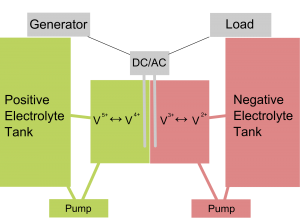
Diagram of a Vanadium Flow Battery
While lithium-batteries have certainly been center stage in the energy storage revolution, flow batteries are gaining ground. Their capabilities and cost/power/density ratios are catching attention. And they have other benefits, from safety to reliability to recycling. This year, experts project that ten times the number of megawatts of flow batteries will be installed as last year. This year’s total global deployment is expected to be 300 MW – the same as lithium-ion seven years ago.
Growth has rocketed as more companies opt for the technology over lithium-ion, particularly for mid-size commercial and small, grid-scale applications such as community energy projects and sub-stations. Sumitomo Electric Industries of Japan recently installed a 30 MW/60 MWh flow battery at an electricity substation in Japan to provide frequency control and balance renewable generation.
Experts believe that the jump in flow battery projects was due to the success of installations last year, that operating experience is building confidence in this storage buy clonazepam pills technology. Flow batteries have strong sustainability credentials. There’s still not a proper recycling infrastructure in place for lithium-ion chemistry. However, if you take flow batteries, when the electrolyte is taken out at the end it’s still as good as it was in the beginning, so it can be re-sold or re-used. Expert noted and summarized that, “Made of plastic, with virtually no fire risk, with long lifetimes and high level of recyclability, the declining costs of flow batteries means that we are likely to see more of these coming into service soon.”
There seem to be specific market segment in focus. Analysts do not think that flow batteries will become the market choice over lithium-ion batteries in small-scale applications such as electric vehicles and domestic energy storage systems. There are different batteries best suited to long duration or short duration systems. Thus far, lithium-ion batteries are the chemistry of choice for short-duration, discharge needs.
So What the Heck is a “Yield Co”?
 The renewable energy industry is evolving. Renewable project developers have been at work for some years building wind farms and solar arrays. Now a new business model comes into play related to “old” systems. Welcome to the world of “Yield Cos” These are companies that buy wind and solar systems, and operate them given consistent yields – with almost no risk – for years. They are steady investments, non-volatile, and devoid of the risk and returns of project development.
The renewable energy industry is evolving. Renewable project developers have been at work for some years building wind farms and solar arrays. Now a new business model comes into play related to “old” systems. Welcome to the world of “Yield Cos” These are companies that buy wind and solar systems, and operate them given consistent yields – with almost no risk – for years. They are steady investments, non-volatile, and devoid of the risk and returns of project development.
Technically, a “yield co” is a company that is formed to own operating assets that produce a predictable cash flow, primarily through long-term contracts. Separating volatile activities (development, research and development, and construction) from stable and less volatile cash flows of operating assets can lower the cost of capital.
Yield cos are common in the energy industry, particularly in renewable energy to protect investors against regulatory changes. They serve the same purpose as master limited partnerships and real estate investment trusts, which most utilities can’t form due to regulatory constraints. Yield cos give investors a chance to participate in renewable energy without many of the risks associated with it.
The number of yield cos grew rapidly in 2013 and 2014 through initial public offerings. They include NextEra Energy Partners, NRG Yield, Brookfield Renewable Energy Partners, TransAlta Renewables, Pattern Energy Group, Abengoa Yield PLC, Hannon Armstrong Sustainable Infrastructure, TerraForm Power, TerraForm Global, and 8point3 Energy Partners.
8point3 Energy Partners, for example, went public in June of 2015 and is a San Jose growth-oriented limited partnership formed by First Solar and SunPower to own, operate, and acquire solar energy generation projects. Its primary objective is to generate predictable cash distributions that grow at a sustainable rate. It does this by acquiring high-quality solar assets primarily developed by its sponsors that generate long-term contracted cash flows and serve utility, commercial and industrial, and residential customers in the United States and other select markets, primarily within OECD countries. Its initial portfolio includes interests in 432 MW of solar energy projects.
U.S. Rooftop Photovoltaic Potential

NREL Facility in Golden, Colorado
The National Renewable Energy Laboratory (NREL) in Golden, Colorado has completed an analysis of rooftop solar potential that doubles previous estimates. The new analysis shows that rooftop solar could provide up to 40% of the nation’s power requirement. Analysts attribute the new findings to increases in module power density, improved estimation of building suitability, higher estimates of the total number of buildings, and improvements in PV performance simulation tools.
NREL scientists used detailed Light Detection and Ranging (LiDAR) data for 128 cities nationwide, along with improved data analysis methods and simulation tools, to update its estimate of the technical potential for rooftop photovoltaic systems. The analysis reveals a technical potential of 1,118 gigawatts (GW) of capacity and 1,432 terawatt-hours (TWh) of annual energy generation, 39% of the nation’s electricity sales.
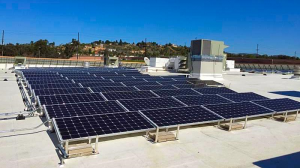
Rooftop Solar on a Movie Theater in Anaheim, CA
Within the 128 cities studied, the researchers found that 83% of small buildings have a suitable location for PV installation, but only 26% of those buildings’ total rooftop area is suitable. Because of the sheer number of this class of building across the country, small buildings provide the greatest combined technical potential. Altogether, small buildings could accommodate 731 GW of PV capacity 65% of the country’s total rooftop technical potential. Medium and large buildings have a potential of 386 GW, 35% of the total technical potential of rooftop PV.
The report only estimates the potential from existing, suitable rooftops, and does not consider the immense potential of ground-mounted PV. Urban area generation could exceed the estimates by installing systems on less suitable roof space, by mounting PV on canopies over open spaces such as parking lots, or by integrating PV into building facades. Naturally the results are sensitive to module performance, expected to continue improving over time.
NREL’s potential study was supported by the U.S. Department of Energy’s SunShot Initiative. SunShot is a collaborative national effort to “aggressively drive innovation” to make solar energy fully cost-competitive with traditional energy sources before the end of the decade. Through SunShot, the Department supports efforts by private companies, universities, and national laboratories to drive down the cost of solar electricity to $0.06 per kilowatt-hour.
Dutch and Danish Energy Islands
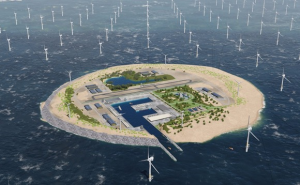
TenneT Vision of an Energy Island in the North Sea
TenneT is a Dutch, state-owned power grid operator. Recently it unveiled plans for an island energy hub in the North Sea, part of a larger strategy to expand Europe’s renewable power generating capacity. The island will be located in the shallow waters of the Dogger Bank, 100 km off the east coast of England where the North Sea has a depth of only 10 to 20 meters. This makes this location ideal for the island and the construction of as many as 7,000 wind turbines, 70 GW of capacity, enough electricity for 10 million people.
The vast scale of the wind farm makes the idea of creating an island a viable option. The bare island itself will cost approximately $3.3 billion. That excludes the construction costs of facilities such as a runway, a harbor, housing for 2,000 workers who will be stationed there, and even a park.
Samso is Denmark’s Energy Island, and it’s all about renewables too. The project began after Denmark’s Minister for the Environment returned from the Kyoto Climate Talks in Japan, enthusiastic about his country reducing its carbon emissions. In 1997, he announced a competition asking local communities or islands to present “the most realistic and realizable plan” for a 100% transition to self-sufficiency through renewable energy. Samso was announced the winner and received funding by the Danish Energy Authority to formulate the details of its master plan.
Samso’s long-term goal is to be a fossil-free island, phasing out oil, gas and coal by 2030.Within ten years, Samso was generating more electricity from renewable energy than it consumed, mainly from 11 onshore and 10 offshore wind turbines, totaling 34 megawatts. Samso’s CO2 footprint is negative 12 tons per inhabitant, which includes the 10 offshore turbines that were built to compensate for carbon emissions from the transportation sector. That compares to the average Danish CO2 footprint of 10 tons per inhabitant.
Nine of the 11 onshore wind turbines were bought by farmers, and the remaining two bought by more than 500 people who live on the island or have summer homes there. The island has four district heating plants, three of which use straw, a by-product of growing barley, and one uses wood chips from local forests in Samso combined with solar thermal panels used to heat water. One plant is owned by 240 households, one by a private farmer and two by the energy company NRGi.
Conversation is underway regarding the ownership model of the district plants with thoughts on new heating concepts that would combine straw and solar power with heating pumps. These plants would use less straw, thereby providing the opportunity to build a new biogas plant that would fuel cars and a new gas ferry that will soon be available in addition to the diesel-powered ferry.
In-Line Hydro Generators
Hong Kong has a network of water mains travelling over 4,847 miles, which is comprehensively monitored to make sure its water supply remains clean and well maintained. Water mains need power for those devices. Conventionally, they are powered by putting small turbines in pipes to produce electricity from drinking water.
Good news: Specialists in hydrodynamics, mechanical engineering, and renewable energy have created highly efficient devices to harness the power of water, specifically to tap the power of wasted water pressure. The system consists of an external hydroelectric generator and highly efficient spherical water turbine that dips into flowing water and reclaims residual pressure. When water passes through, the turbine drives a central rotating shaft and a micro generator to produce electricity.
The key lies in intelligent design to extract energy from flowing water. In optimal scenarios, the turbine only takes away a fraction of kinetic energy. It strikes an accurate balance between water volume, water pressure, and consumption of hydrokinetic energy, which boosts efficiency without reducing the momentum of running water to guarantee a reliable water supply. Turbine blades are carefully sized to intersect the largest possible area of water flow and minimize water bypassing.
“We’re capturing energy that would otherwise be lost,” says Priddy, director of operations for Lucid Energy, a Portland start-up.
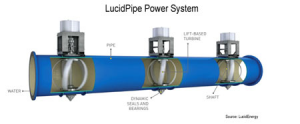
Source: Lucid Energy
In January, Lucid became the first company in the U.S. to install a commercial micro-hydro energy system, flipping the switch on 1,100 megawatts of renewable energy. Torrents of water rush beneath cities all over the world. In Portland’s case, the water moves at an average rate of 39,000 gallons per minute. Lucid harnesses that energy with a system that’s striking in its simplicity.
For example, twenty feet below a street in Portland, Oregon, and inside city-owned water pipes, are four keg-size turbines that look like giant egg beaters-only they churn out hydroelectric power. The only technology inside the water pipes are five-bladed spherical turbines, 42 inches in diameter, made of stainless steel and composite fiber. Most of the other parts-seals, bearings, grid connections-sit outside them. “The whole system is designed so water delivery is never disrupted.
Lucid’s system works in gravity-fed pipes, which makes them a good fit for western and northeastern states, where water rushes downhill into showers and sprinklers. Sensors in the pipes provide data on water pressure and quality, which can forewarn of burst pipes or water contamination. A pilot project in Riverside, California, in 2012 demonstrated the safety and potential of the system. As a result, the company’s turbines are certified for use in pipes that carry municipal drinking water, as well as industrial, irrigation, and wastewater.
These systems can be installed with third-party financing. Harbourton Alternative Energy provided the capital for the $1 million installation cost in Portland. The city, the Portland Water Bureau, and investors will share revenue generated by the turbines for the next 20 years.
The LucidPipe™ Power System can reportedly operate across a wide range of flow conditions, volumes, and velocities. The amount of electricity generated is a function of the rate of flow and the pressure inside the transmission pipe. For example, in a standard 60-inch-diameter pipeline, with flow velocity of seven feet per second and 92.3 ft of head (40 psi) of excess head pressure, a single LucidPipe unit could produce up to 100 kW of power while extracting about 11.5 feet of head (5 PSI) from the system. One mile of 42” diameter pipeline could produce as much as 3 megawatts or more of electricity.
A second company, NLine Energy, presents a similar energy management proposition: The problem – or opportunity – is inefficient water transmission. NLine notes that for every one foot of elevation difference, water gains .433 pounds per square inch (psi) of pressure. In areas of high elevation difference, it is common to have elevation drops in excess of 200 – 500 feet within a water distribution network. Problems arise for water agencies if pressure accumulates in a distribution system.
In order to mitigate excess pressure, a network of pressure reduction valves (PRVs) has been installed throughout water distribution systems to lower the pressure to optimal levels. Excess pressure, in the form of heat and noise, is vented into the atmosphere. PRVs do not perform useful work with the energy they remove from the system.
To harness this wasted energy, NLine’s Water to Energy Recovery System (WATERSSM) is installed to capture the wasted energy at PRV sites and convert it into renewable electricity. WATERSSM consists of a turbine-generator, energy storage devices, electronic controls, bypasses and fail-safes, environmental and security equipment, sensors, communications and data equipment, and an information collection, control and reporting system capable of operating either manually or autonomously
Welcoming New Staff

Sumiun Sohn
Sumin Sohn is EcoMotion’s Prop 39 Project Manager. She brings experiences in project management and data analysis to EcoMotion, as well as passion and breadth of knowledge in the field of sustainability. Born in Korea, Sumin has also lived in Hong Kong, Australia, and Brazil. Sumin did undergraduate studies at University of Pennsylvania and earned two graduate degrees from Harvard University. She then worked at the Walt Disney Company for over three years, leading a cross-functional team to implement research projects in Nicaragua and Vietnam. More recently Sumin earned certificates in Sustainability and Project Management from UCLA, interned at Global Green, and earned her LEED Green Associate distinction.
At EcoMotion, her primary duty is to serve as our Prop 39 Project Manager, managing energy efficiency and renewable energy projects at school districts in California… specifically in Monterey, Riverside, Orange, and San Diego counties.

Shaun Miller
Shaun Miller was born and raised in Illinois, educated there and in Texas. He’s a wrestler and cross-country bicyclist, and has already brought great value to EcoMotion where he serves as project manager for EcoMotion’s ongoing Metro works.
Shaun brings years of project management and business development experience in the global energy industry. He has managed materials and personnel on natural gas mega-projects in Africa and led transmission and distribution projects for electric utilities in Texas. Most recently, he’s driven energy solutions projects for schools and businesses in California working on efficient lighting and controls projects. Shaun is a LEED Green Associate and is newly settled in the Montecito Heights neighborhood of east Los Angeles with his wife and newborn son. Shaun holds a Master of Arts in Philosophy from University of Houston in Houston, Texas, and a Bachelor of Arts in Philosophy from Millikin University in Decatur, Illinois..
